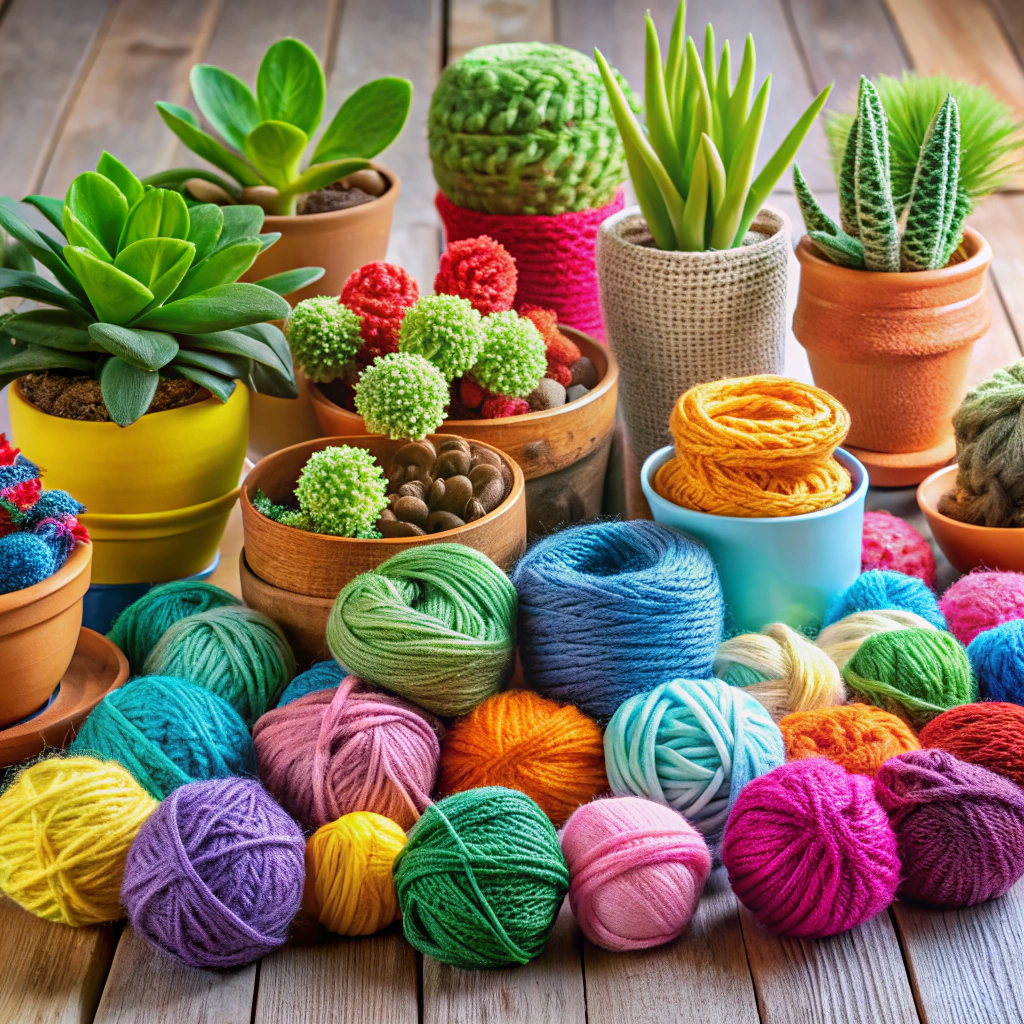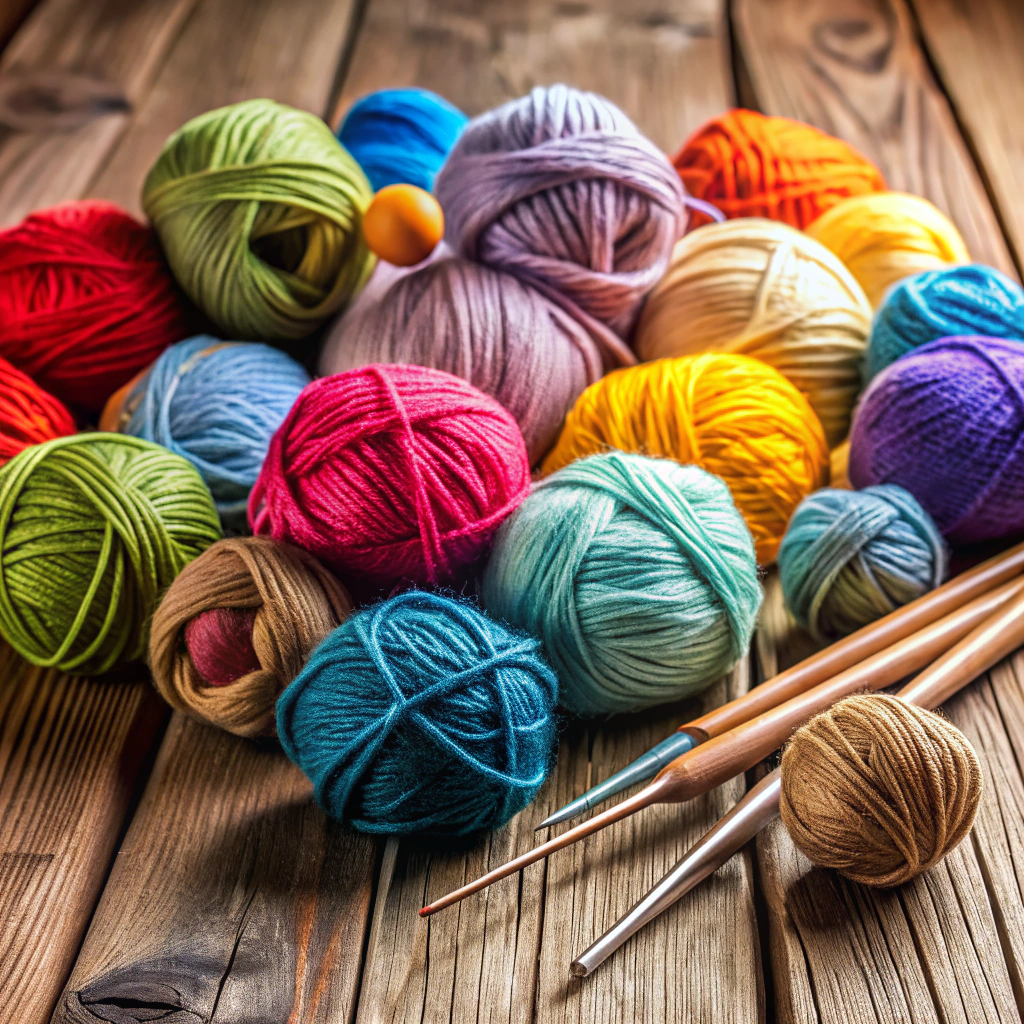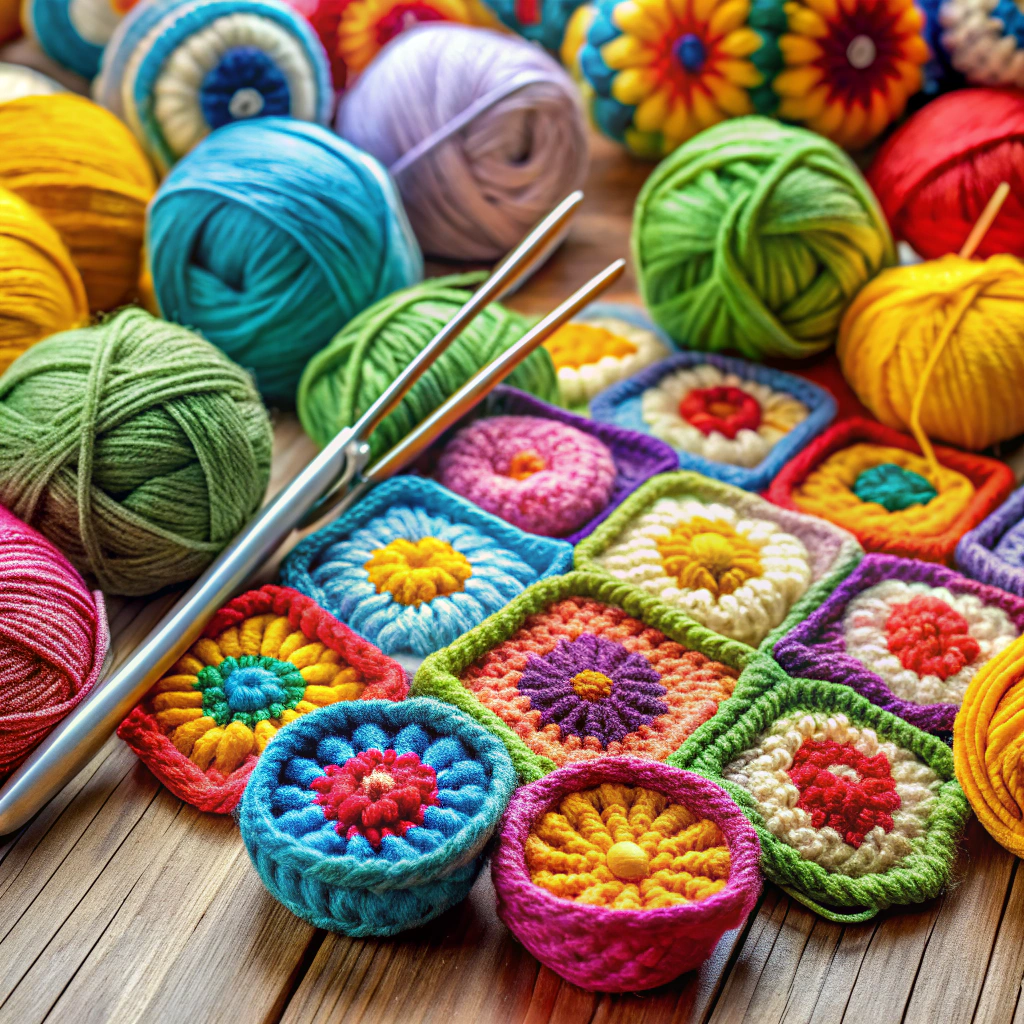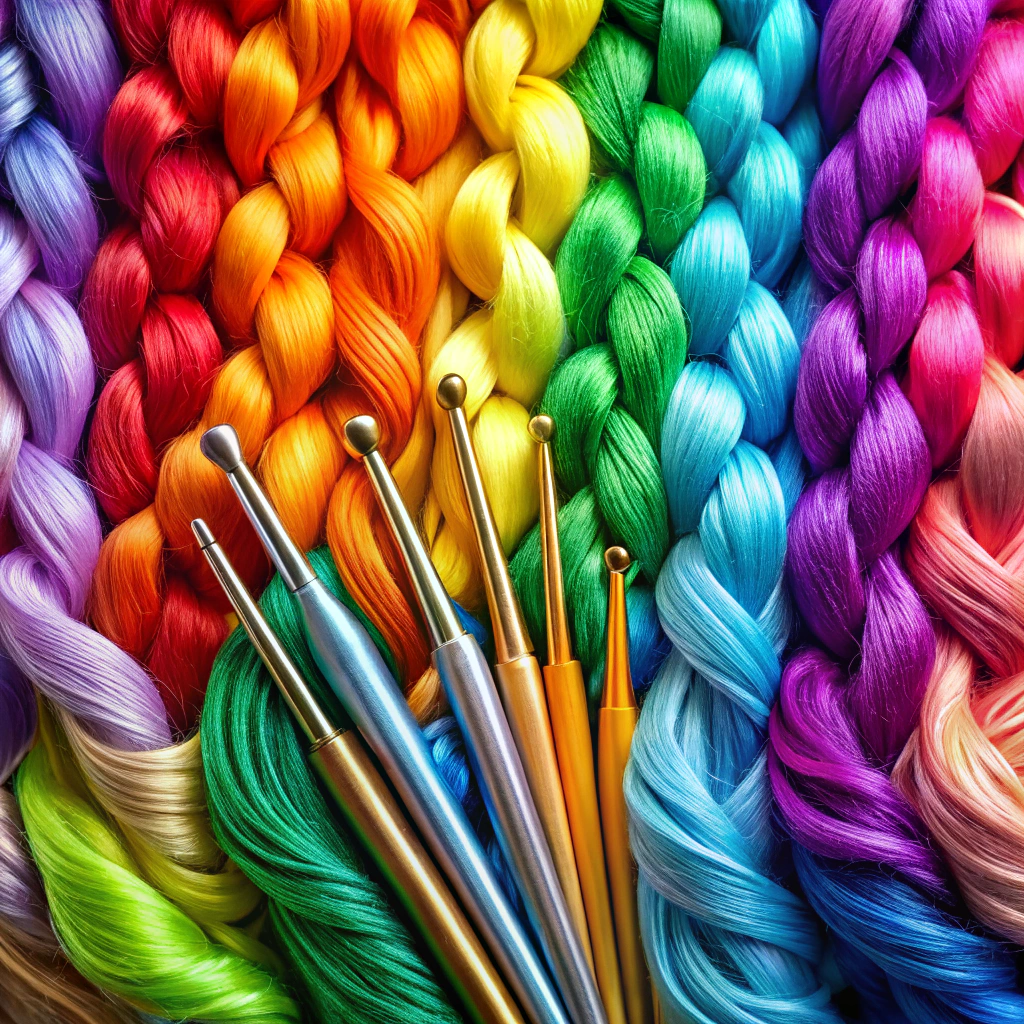Discover the diverse world of crochet wool as we delve into its various types, textures, and characteristics that can elevate your crafting experience.
Crochet is one of the most popular and versatile crafts in the world, loved by millions for its ability to create beautiful and unique items. But when it comes to choosing the right wool for your project, things can get a little overwhelming.
With so many different types of wool available, each with their own properties and characteristics, it can be hard to know where to start. That’s why we’re here today – to guide you through the wonderful world of crochet wool and help you choose the perfect yarn for your next project! From soft merino wool to durable acrylic blends, we’ll explore all the different types of crochet wool on offer and give you all the information you need to make an informed decision.
So grab your hook and let’s get started!
Fiber Type
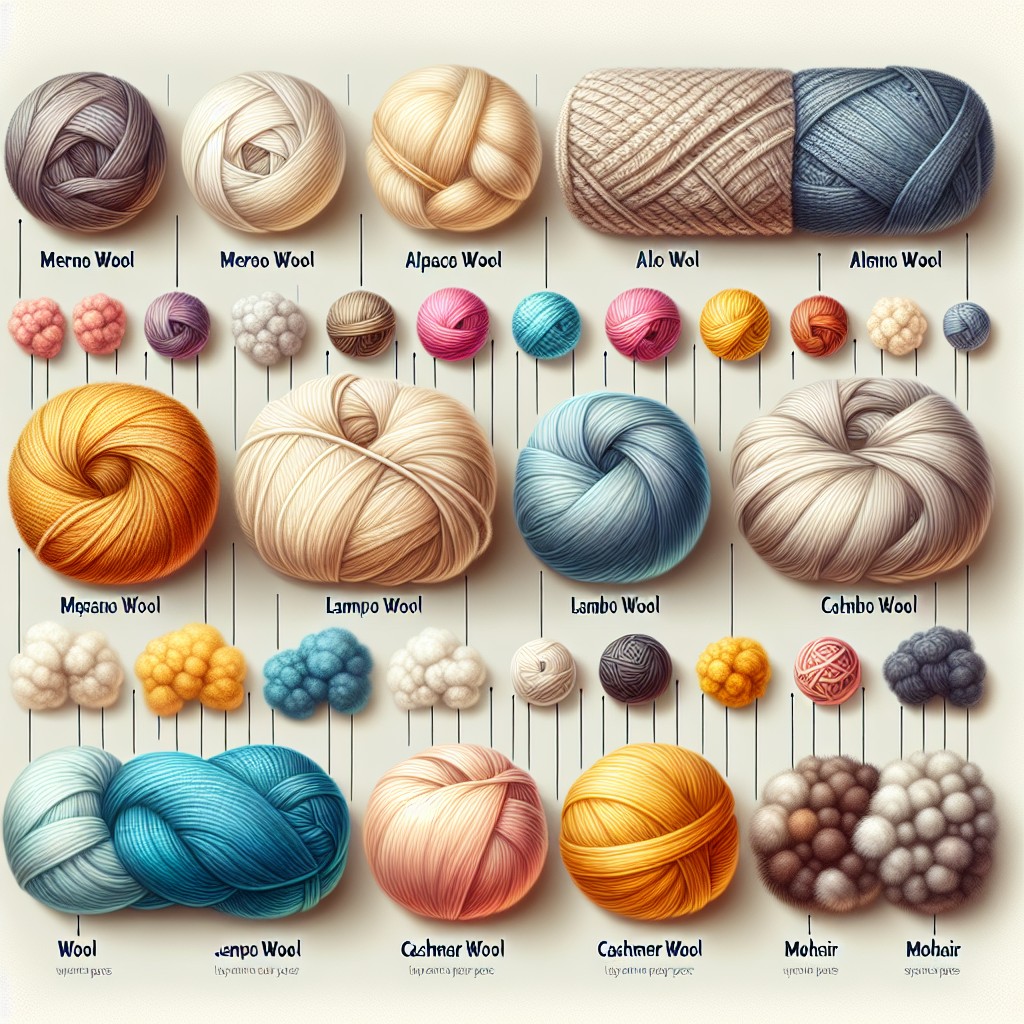
When it comes to choosing the right type of yarn for your crochet project, one of the most important factors to consider is fiber type. The fiber content of a yarn can have a significant impact on its texture, durability, and overall appearance.
Some common natural fibers used in crochet include wool (which can be sourced from sheep or other animals like alpacas), cotton (made from plant fibers), and silk (derived from silkworms). Synthetic fibers such as acrylic are also popular due to their affordability and ease-of-care.
Each fiber has its own unique properties that make it suitable for different types of projects. For example, wool is known for being warm and durable – making it ideal for cozy winter accessories like hats or scarves.
Cotton is lightweight with excellent breathability – perfect for summer garments like tank tops or beach cover-ups.
It’s essential to understand how each fiber behaves when selecting your yarn so you can choose the best option based on your project needs.
Yarn Vs. Thread
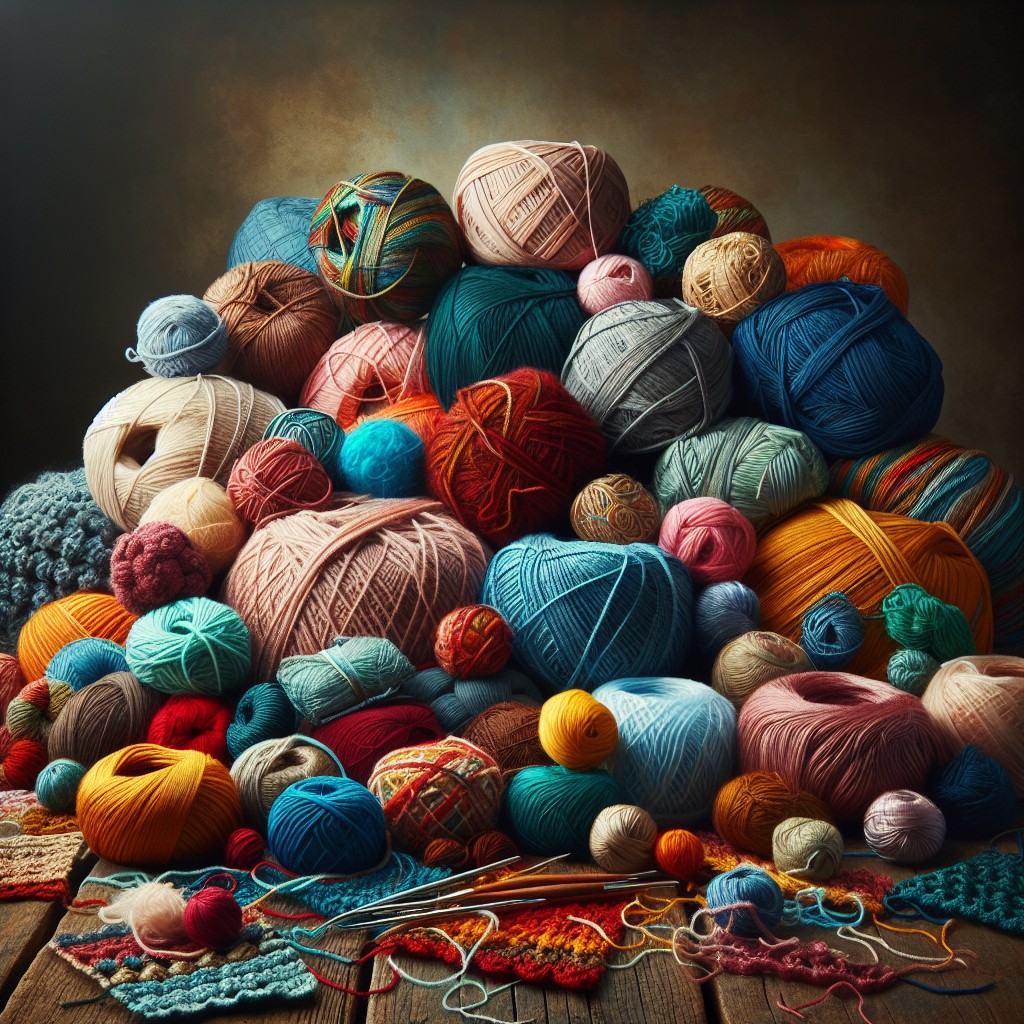
While they may seem similar at first glance, there are some key differences between the two that can affect your project’s outcome.
Yarn is typically thicker than thread and is made up of multiple plies twisted together. It comes in a variety of weights, from super fine to super bulky, making it suitable for a wide range of projects.
Yarn also tends to have more stretch and give than thread.
Thread, on the other hand, is much thinner than yarn and usually only has one or two plies twisted together. It’s often used for delicate work such as lace doilies or intricate motifs where finer details are required.
Choosing between yarn vs. Thread ultimately depends on what you’re making – if you’re working on a larger project like an afghan or sweater then yarn would be more appropriate due to its thickness; whereas if you’re creating something small with intricate details like jewelry pieces then using threads would be better suited because they allow for greater precision in your stitches.
Yarn Weights

Yarn weight refers to the thickness of the yarn, which can range from superfine (lace) to super bulky (jumbo). Each weight has its own unique characteristics and is best suited for specific projects.
The most common types of yarn weights include lace, fingering, sport, DK (double knitting), worsted/aran, bulky and super bulky. Laceweight is perfect for delicate shawls or doilies while fingering weight works well with lightweight garments such as socks or baby clothes.
Sport-weight is ideal for light sweaters or scarves while DK-weight works great with hats and mittens.
Worsted/aran-weight is one of the most popular types used in crochet projects due to its versatility; it’s suitable for a wide range of items including blankets and afghans. Bulky-weights are thicker than worsted but not as thick as super-bulky; they’re perfect if you want a quick project that still looks substantial like chunky scarfs or cowls.
Natural Fiber Yarn Types

These types of yarns are made from natural materials such as wool, alpaca, cotton, silk or bamboo. Each type of natural fiber has its own unique properties that make it ideal for different projects.
Wool is one of the most commonly used natural fibers in crochet and knitting. It’s warm, durable and comes in a variety of textures ranging from soft to coarse.
Merino wool is particularly popular due to its softness and versatility.
Alpaca yarn is another favorite among crafters because it’s incredibly soft yet lightweight making it perfect for cozy winter garments like scarves or hats.
Cotton yarn offers excellent breathability which makes it great for summer clothing items like tank tops or beach cover-ups. It also comes in many colors making it easy to find the perfect shade for your project.
Silk adds an elegant touch to any project with its luxurious sheen but can be more challenging to work with than other fibers due to its slippery texture.
Bamboo is becoming increasingly popular as an eco-friendly alternative since bamboo plants grow quickly without pesticides or fertilizers needed during cultivation.
Synthetic Yarn Types (Man-Made Yarn Fibers)
These yarns can be made from a variety of materials such as polyester, nylon or acrylic. They tend to be more affordable than natural fiber options and often come in bright colors that don’t fade over time.
Acrylic is one of the most popular synthetic yarn types due to its versatility and affordability. It’s easy to care for since it can be machine washed without losing its shape or color.
Acrylic is also hypoallergenic which makes it an excellent choice for those with sensitive skin.
Nylon is another common synthetic fiber used in crochet projects because it’s strong and durable while still being lightweight enough not to weigh down your project.
Polyester has similar properties but tends to have less stretch than other synthetic fibers like nylon or acrylic making it ideal for items that need structure like bags or baskets.
Types of Yarn Weights
Yarn weight refers to how thick or thin a strand of yarn is and can have a significant impact on the final look and feel of your finished item. There are several different types of yarn weights available, ranging from super fine laceweight all the way up to super bulky.
The most common types of yarn weights include:.
- Laceweight: This type of yarn is incredibly thin and delicate, making it perfect for intricate lacework or lightweight shawls.
- Fingering/sock: Slightly thicker than laceweight but still quite thin, fingering/sock weight yarns are ideal for socks (as their name suggests) as well as lightweight garments like summer tops.
- Sport/DK: These two categories are often grouped together because they’re similar in thickness – sport being slightly thinner than DK (double knitting). They’re great choices for baby clothes or light sweaters.
- Worsted/Aran: A medium-weight option that’s versatile enough for everything from hats and scarves to blankets and afghans.
- Bulky/Chunky: As their names suggest these options produce chunkier results which makes them great picks when you want something cozy like winter accessories such as hats & mittens
- Super Bulky/Jumbo : The thickest category available; this type produces quick projects with large stitches that make them perfect if you need something done quickly.
Merino Wool
This type of wool comes from Merino sheep that are bred mainly in Australia and New Zealand. The fibers of this wool are finer than regular sheep’s wool, making it softer to the touch and less likely to cause itching or irritation on sensitive skin.
Merino yarns come in different weights ranging from lace weight (the thinnest) up to bulky weight (the thickest). It can be used for various projects such as scarves, hats, sweaters or blankets.
Due to its natural elasticity and breathability properties merino yarn is also great for active wear like socks or sportswear.
One thing you should keep in mind when working with merino yarn is that it requires special care during washing since it tends to shrink if not handled properly. To avoid this issue always follow the washing instructions provided by the manufacturer carefully.
Wool
It’s a natural fiber that comes from sheep, goats, alpacas, and other animals. Wool is known for its warmth, durability, and versatility in crafting.
There are different types of wool available depending on the animal it comes from. For example:
- Merino wool: This type of wool comes from merino sheep and is known for being soft to the touch.
- Shetland wool: This type of wool comes from Shetland sheep and has a slightly rougher texture than merino but still feels comfortable against your skin.
- Alpaca yarn: Alpaca fibers are similar to those found in cashmere or angora – they’re incredibly soft with a silky sheen.
When choosing which type of wool to use for your project consider factors such as how warm you want it to be or if you have any allergies (some people may be allergic to certain animal fibers).
Alpaca Yarn
It’s made from the fleece of alpacas – a domesticated South American animal that resembles a small llama. Alpaca wool comes in two types: Huacaya and Suri.
The former has fluffy, crimpy fibers while the latter has long straight locks that drape beautifully.
One of the benefits of using alpaca yarn is its hypoallergenic properties which make it an excellent option for those with sensitive skin or allergies to other types of wool. It’s naturally water-repellent and flame-resistant making it ideal for items like blankets or scarves.
When working with alpaca yarns keep in mind that they tend to be heavier than other fibers so you may need larger hooks or needles when crocheting your project. Also note that because this type of fiber doesn’t have as much elasticity as others (like merino), you’ll want to avoid over-stretching your stitches during crochet work.
Bamboo
It’s made from the pulp of bamboo grass and is known for its softness, durability, and eco-friendliness. Bamboo yarns are often blended with other fibers such as cotton or wool to create unique textures and colors.
One of the benefits of using bamboo yarn is its sustainability. Bamboo grows quickly without the need for pesticides or fertilizers, making it an environmentally friendly choice compared to other types of fibers like cotton or wool.
In addition to being sustainable, bamboo yarn also has natural antibacterial properties which make it ideal for items like dishcloths or baby blankets that require frequent washing. Its moisture-wicking abilities also make it great for summer garments as well as winter accessories since it can keep you cool in hot weather while still providing warmth when temperatures drop.
Fabric / T-Shirt
It’s made from recycled t-shirts and other fabric scraps, making it an eco-friendly option for those who want to reduce their environmental impact. This type of yarn is perfect for creating chunky, textured projects like rugs, baskets or bags.
T-shirt yarn comes in a variety of colors and textures depending on the source material used to create it. The thickness can vary as well since the width of each strip depends on how wide you cut them from your old shirts.
One great thing about T-shirt yarn is that it’s easy to work with – even if you’re new to crochet! Its soft texture makes it comfortable against your skin while its stretchiness allows for flexibility when working with different stitch patterns.
Acrylic Yarn
It’s made from synthetic fibers that are easy to care for and come in a wide range of colors and textures. Acrylic yarn is perfect for beginners who want to practice their skills without breaking the bank or worrying about ruining expensive wool.
One of the benefits of acrylic yarn is that it’s machine washable, making it ideal for items like blankets or children’s toys that need frequent washing. It also holds up well over time with minimal pilling or stretching.
Another advantage of acrylic yarn is its ability to mimic natural fibers like wool or cotton while being more affordable than those materials. This makes it an excellent option when you want the look and feel of high-end fiber but don’t have the budget.
However, some downsides exist as well; acrylic can be less breathable than natural fibers which may make garments uncomfortable in hot weather conditions.
Cotton
It’s also hypoallergenic and easy to care for – making it perfect for baby items or anyone with sensitive skin. Cotton yarn comes in a range of weights from lace weight to bulky weight, so you can use it for everything from delicate shawls to cozy blankets.
One of the benefits of cotton yarn is that it doesn’t stretch as much as other fibers like wool or acrylic. This makes it ideal if you’re looking for stitch definition in your crochet projects – meaning that your stitches will be more defined and stand out better than they would with stretchier fibers.
Another advantage of cotton yarn is that it’s absorbent – which means that any items made with this fiber will be great at soaking up moisture (think dishcloths!). Plus, because cotton doesn’t retain heat well compared to other materials like wool or alpaca fiber; garments made from this material are perfect during warmer months when temperatures rise.
Cotton Threads
Cotton is a natural fiber that comes from the cotton plant’s seedpod. It is known for its breathability and absorbency, making it an excellent choice for summer garments or items that will be in contact with skin.
When choosing cotton thread for your project, consider the weight of the yarn as well as its texture. Some cotton threads have a smooth finish while others have more texture or even slubs (thick spots).
The weight of the yarn can also vary greatly – from fine laceweight to bulky.
One thing to keep in mind when working with 100% cotton thread is that it has less elasticity than other fibers like wool or acrylic. This means you may need to adjust your tension when working on certain projects such as amigurumi toys where tight stitches are necessary.
Natural & Acrylic Mixes
These blends offer the durability and affordability of synthetic fibers with the softness and warmth of natural fibers. They also tend to be easier to care for than pure wool or cotton yarns, making them ideal for everyday use items like blankets or scarves.
One popular type of blend is wool-acrylic mixtures which combine warm wool with durable acrylic fiber. This combination creates a soft yet sturdy fabric that’s perfect for winter wearables like hats, gloves, and sweaters.
Another common blend is cotton-acrylic mixtures which provide all-season comfort while being easy on your wallet too! Cotton adds breathability while acrylic gives it strength so it can withstand frequent washing without losing its shape or color.
Natural & Acrylic Mixes are great options if you want something affordable but still high-quality in terms of texture and durability.
Common Questions About Yarn Types
Here are some common questions that people ask when choosing their yarn:.
– What is the Softest Type of Yarn? The softness of a yarn depends on its fiber content and how it’s spun. Generally, merino wool and alpaca are considered some of the softest fibers available.
– What Type of Yarn Should I use for Hot Pads? When making hot pads or other items that will be exposed to heat, you’ll want to choose a durable cotton or acrylic blend that can withstand high temperatures.
– Is Yarn Different for Knitting vs Crochet? While there isn’t necessarily a difference in the type of yarn used between knitting and crochet, certain patterns may call for specific weights or textures depending on whether you’re knitting or crocheting.
– What is Faux Fur Yarn Made Of? Faux fur yarns can be made from synthetic materials like polyester or nylon. They mimic real animal fur but without harming any animals in their production process.
What Is the Softest Type of Yarn?
One of the most popular choices is merino wool, which is known for its incredibly soft and luxurious feel. Merino wool comes from merino sheep and has a fine texture that makes it perfect for creating cozy blankets, scarves, and sweaters.
Another option for those seeking ultra-softness is alpaca yarn. Alpaca fibers are naturally hypoallergenic and softer than traditional sheep’s wool.
This makes them ideal for people with sensitive skin or anyone looking to create something extra snuggly.
If you’re looking for an alternative to animal-based fibers, bamboo yarn may be just what you need! Bamboo fiber has a silky smooth texture that feels amazing against your skin while also being eco-friendly.
What Type of Yarn Should I Use for Hot Pads?
The best type of yarn for this purpose is 100% cotton. Cotton is a natural fiber that has excellent heat resistance and durability, making it perfect for creating items like pot holders and oven mitts.
Cotton yarn also has the added benefit of being easy to clean – simply toss your hot pad in the washing machine with your regular laundry! However, keep in mind that not all cotton yarns are created equal. Look for brands specifically labeled as “kitchen cotton” or “dishcloth cotton,” as these are designed to be extra absorbent and durable.
Avoid using synthetic fibers such as acrylic or polyester blends when making hot pads since they have low heat resistance levels which could cause them to melt under high temperatures leading to burns on your hands while handling pots from the stove top or oven.
If you want long-lasting and effective hot pads then choose 100% kitchen/dishcloth cotton over other types of wool available out there.
Is Yarn Different for Knitting Vs Crochet?
The answer is no – the same types of yarn can be used for both crafts. However, there are some differences in how you might use the yarn depending on which craft you’re doing.
For example, when crocheting, it’s generally easier to work with thicker or bulkier weight yarns as they allow your stitches to stand out more and make it easier to see where your hook needs to go next. On the other hand, when knitting intricate patterns or lacework designs with lots of holes in them (like shawls), thinner weight threads may be preferred.
Ultimately though, choosing a type of wool depends on what kind of project you’re working on and personal preference.
What Is Faux Fur Yarn Made Of?
But what exactly is faux fur yarn made of? Unlike traditional wool or cotton, faux fur yarn is typically made from synthetic fibers such as polyester or acrylic. These fibers are designed to mimic the look and feel of real animal fur, without harming any animals in the process.
One thing that sets faux fur apart from other types of yarn is its unique texture. Faux fur has a soft, fluffy feel that can add depth and dimensionality to your crochet work.
It’s also incredibly warm – perfect for creating cozy blankets, scarves, hats and more.
When working with faux-fur yarns it’s important not only consider how they will affect your project but also how they will be cared for after completion since many require special care instructions when washing them.
How Is Self Striping Yarn Made?
But have you ever wondered how this magical effect is achieved? Self-striping yarn is made by dyeing sections of the skein in different colors, creating a repeating pattern that produces stripes when worked up. The length and width of each section can vary depending on the desired effect, with some self-striping yarns featuring wide bands of color while others have shorter segments for more subtle striping.
The process used to create self-striping yarn can be quite complex and involves careful planning and execution from start to finish. First, the manufacturer must decide on which colors they want to use in their stripe sequence before carefully measuring out each section’s length and width using precise calculations.
Once these measurements are determined, it’s time for dye application! Each segment receives its unique hue through immersion into individual vats filled with colored dyes or by applying them directly onto specific areas using brushes or other tools.
After all sections are dyed according to plan (which may take several rounds), they’re then spun together into one continuous strand – voila! A beautiful skein ready for your next project!.
What Type of Yarn Is Best for Crocheting Blankets?
You want a yarn that is soft and cozy, yet durable enough to withstand frequent use and washing. One popular option for crochet blankets is acrylic yarn.
Acrylic yarns are affordable, easy to care for, and come in a wide range of colors and textures.
Another great option for crochet blankets is wool or wool blends such as merino wool or alpaca yarn. These natural fibers provide warmth without being too heavy or bulky while also adding an element of luxury to your blanket.
Cotton can also be used for crocheting lightweight summer blankets that are breathable but still offer some warmth on cooler nights.
Types of Yarn By Fiber Source
Different fibers have different properties and characteristics that can affect everything from texture and drape to durability and washability. Here are some of the most common types of yarn by fiber source:
Animal Fiber Types: Wool is perhaps the best-known animal fiber used in crochet, prized for its warmth, softness, and elasticity. Other popular animal fibers include alpaca (known for its silky softness), mohair (known for its fluffy texture), cashmere (known for its luxurious feel) as well as silk.
Plant Fiber Types: Cotton is a popular plant-based option due to being lightweight with excellent breathability making it perfect during summer months or warmer climates. Bamboo has become increasingly popular in recent years due to being eco-friendly while also having a similar feel like silk.
Linen has been around since ancient times known not only because it’s durable but also because linen gets softer with each wash.
Animal Fiber Types of Yarn
These fibers come from a variety of animals, including sheep, alpaca, and even rabbits! Each animal fiber has its own unique properties that make it ideal for different types of projects.
Wool is one of the most common animal fibers used in crochet. It comes from sheep and is known for its warmth and durability.
Merino wool is a particularly soft type of wool that’s perfect for cozy scarves or blankets.
Alpaca yarn is another popular choice among crocheters. This luxurious fiber comes from South American alpacas and has a silky texture that makes it great for shawls or other delicate items.
Angora rabbit fur produces an incredibly soft yarn with a fluffy texture that’s perfect for hats or sweaters. However, this type can be more expensive than other animal fibers due to the difficulty involved in harvesting it.
Plant Fiber Types of Yarn
These types of yarns are made from plant-based sources such as cotton, bamboo, linen, hemp, and more. Cotton is one of the most commonly used plant fibers in yarn production due to its softness and versatility.
It’s perfect for creating lightweight garments like summer tops or baby blankets.
Bamboo is another popular option that has gained popularity in recent years due to its sustainability factor. This type of fiber produces a silky smooth texture that drapes beautifully when crocheted into shawls or scarves.
Linen is known for its durability and strength which makes it ideal for items like dishcloths or market bags that require frequent washing.
Hemp has been gaining popularity as an alternative to cotton because it requires less water during cultivation making it more sustainable than traditional cotton farming methods.
Types of Yarn By Weight
Yarn weight refers to how thick or thin a strand of yarn is and can have a significant impact on the final look and feel of your finished item. There are several different types of yarn weights available, ranging from super fine laceweight all the way up to super bulky.
The most common types of yarn weights include:.
- Laceweight: This type of yarn is very thin and delicate, making it perfect for intricate lacework projects.
- Fingering/sock weight: Slightly thicker than laceweight but still quite thin, this type of yarn works well for lightweight garments like socks or shawls.
- Sport/DK (double knitting) weight: A little thicker than fingering/sport-weight but still relatively light, this type works well for sweaters or other clothing items that require some drape.
- Worsted/Aran Weight: This medium-weight option is great for blankets and heavier clothing items like hats or scarves.
- Bulky/Chunky Weight: As its name suggests, this type features thick strands that work up quickly – ideal if you’re looking to create something cozy in no time!
- By understanding these different types based on their thicknesses (weights), you’ll be able not only choose what’s best suited towards your project needs but also ensure that you get an end product with desired characteristics such as warmth level & texture.
Types of Yarn By Ply
The most common types are singles, 2-ply, 3-ply and so on. Singles are made up of just one strand while plied yarns have multiple strands twisted together.
The ply can affect the texture and durability of the finished project. Single-ply yarn tends to be softer but less durable than plied yarns because it has less structure holding it together.
Plied yarns tend to be stronger and more durable because they have more structure from being twisted with multiple strands.
When choosing a type of ply for your project, consider what you want your finished product’s texture and durability level should be like as well as how easy or difficult it will be for you work with that particular type. Understanding different types of crochet wool is essential in creating beautiful projects that stand out from others’.
How to Choose the Right Type of Yarn for a Pattern
The first step in selecting your yarn is to check the pattern instructions for any specific recommendations. If there are no guidelines, consider factors such as fiber content, weight, and texture.
Fiber content plays a significant role in determining how your finished project will look and feel. Natural fibers like wool or alpaca tend to be warmer and more durable than synthetic fibers like acrylic or nylon but may require special care when washing.
Weight refers to how thick or thin the yarn is and can affect both appearance and drape of your finished item. A heavier weight yarn will create a thicker fabric while lighter weights produce more delicate results.
Texture also impacts final product appearance; smooth textures highlight stitch definition while fuzzy textures obscure it.
Types of Yarn Labels
Yarn labels contain a wealth of information that can help you choose the right type of yarn for your project. Here are some common types of information found on yarn labels:
1. Fiber content: This tells you what materials were used to make the yarn, such as wool, cotton or acrylic.
2. Weight: The weight category indicates how thick or thin the yarn is and helps determine which hook size will work best with it.
3. Yardage/Meterage: This tells you how much yardage/meterage is in each skein/ball/hank so that you know if there’s enough for your project.
4. Care instructions: These tell you how to care for your finished item made from this particular type of wool (e.g., machine washable vs hand-wash only).
5. Dye lot number/Colorway name & number – If buying multiple skeins/balls/hanks at once, ensure they have matching dye lots/colorways so that colors match perfectly when crocheted together.
Other Types of Yarn Factors
One of these is texture – some types of wool have a smooth, even texture that’s perfect for creating clean lines and crisp stitches, while others have a more textured feel that can add depth and dimension to your work. Another factor is color – different types of wool come in an endless array of colors, from bold brights to subtle pastels or earthy neutrals.
And then there’s price – while some high-end wools can be quite expensive, others are more budget-friendly without sacrificing quality.
It’s important to keep all these factors in mind when selecting your crochet wool so you end up with a finished product you’re happy with both aesthetically and functionally.
Types of Yarn – FAQs
Here are a few frequently asked questions about yarn types that can help you make informed decisions when choosing your next project:.
– What is the most common type of yarn? The most common type of yarn is acrylic, which is affordable and widely available in many colors and textures.
– What yarn is used for knitting? Knitting can be done with any type of wool or synthetic fiber. However, some popular choices include merino wool for its softness and warmth or cotton for its breathability.
– What is the most common size (weight) of crochet thread/yarn? The most commonly used weight in crochet thread/yarns are medium-weight (also known as worsted weight), which works well for a wide range of projects from blankets to scarves.
These FAQs provide just a glimpse into the world of crocheting with various types/weights/fibers/colors/textures/etc., but they’re an excellent starting point if you’re new to this craft.
What Is the Most Common Type of Yarn?
Acrylic yarn is a synthetic fiber made from polymer and has become increasingly popular in recent years due to its affordability, durability, and versatility. It’s also easy to care for as it can be machine washed and dried without losing its shape or color.
Acrylic yarn comes in various weights ranging from super fine (also known as fingering weight) all the way up to super bulky. This makes it perfect for a wide range of projects such as blankets, scarves, hats, sweaters – you name it!
While some may argue that natural fibers like wool or cotton are superior when compared with acrylics because they’re more breathable or have better moisture-wicking properties; there’s no denying that acrylics offer an excellent alternative at an affordable price point.
What Yarn Is Used for Knitting?
Knitting requires a specific type of yarn that is different from crochet thread or other types of fibers. The most common types of yarn used for knitting are wool and acrylic blends, which come in various weights and textures.
Wool is a natural fiber that has been used for centuries in textile production. It’s warm, durable, and elastic – making it perfect for creating cozy sweaters or blankets.
Wool also comes in many different varieties such as merino wool (known for its softness), alpaca wool (known for its warmth), and cashmere (known for its luxury).
Acrylic blends are man-made fibers that mimic the properties of natural fibers like wool but at a lower cost point. They’re often preferred by beginners because they’re easy to work with due to their smooth texture.
What Is the Most Common Yarn Size for Crochet?
The thickness of the yarn you choose will determine how big or small your stitches are and ultimately affect the overall look and feel of your finished piece. So what is the most common yarn size for crochet? In general, medium weight (also known as worsted weight) yarns are the most commonly used for crocheting projects.
This type of yarn falls into category 4 on the standard Yarn Weight System and has a recommended hook size range between 5mm-6mm.
Medium-weight acrylic blends are popular choices because they’re affordable, easy to find in stores, come in a wide variety of colors and textures, making them perfect for beginners who want to experiment with different types before committing to more expensive options like wool or alpaca.
However, depending on what you’re making – hats vs blankets vs amigurumi – other weights may be more appropriate.
Types of Yarn – In Conclusion
From natural fibers like merino wool and alpaca to synthetic blends like acrylic, there’s a yarn out there for every project. When choosing your yarn, consider factors such as fiber type, weight, ply and texture to ensure that you get the best results possible.
Don’t be afraid to experiment with different types of yarn – you never know what amazing creations you might come up with! With this guide in hand, we hope that you feel more confident in navigating the wonderful world of crochet wool and finding the perfect yarn for your next project. Happy crocheting!
FAQ
Which type of wool is best for crochet?
The best type of wool for crochet, especially for beginners, is worsted and bulky weight yarns as they fall in the middle of the weight list and have clear hook recommendations provided by the Craft Yarn Council.
What are the 3 types of yarn?
The 3 types of yarn are Animal Fibers, Plant Fibers, and Synthetic Fibers.
What type of yarn is used for crochet?
Answer: The types of yarn used for crochet include wool, cotton, and acrylic, with acrylic being the most versatile choice, especially for beginners.
What are the types of wool yarn?
The types of wool yarn include sheep wool, alpaca, cashmere (from goats), pashmina (from Tibetan mountain goats), shahtoosh (from Tibetan antelopes), Angora (from Angora rabbits), and mohair (from Angora goats).
Which fiber types are most suitable for crocheting projects?
“Suitable fiber types for crocheting projects include cotton, wool, acrylic, and blends of these materials.”
How can I choose the right wool yarn for my crochet project?
To choose the right wool yarn for your crochet project, consider factors such as desired texture, thickness, color, and fiber quality.
What are the differences between various crochet yarn textures?
Answer: Various crochet yarn textures differ in terms of thickness, softness, and material, affecting the overall appearance, feel, and durability of the finished product.
